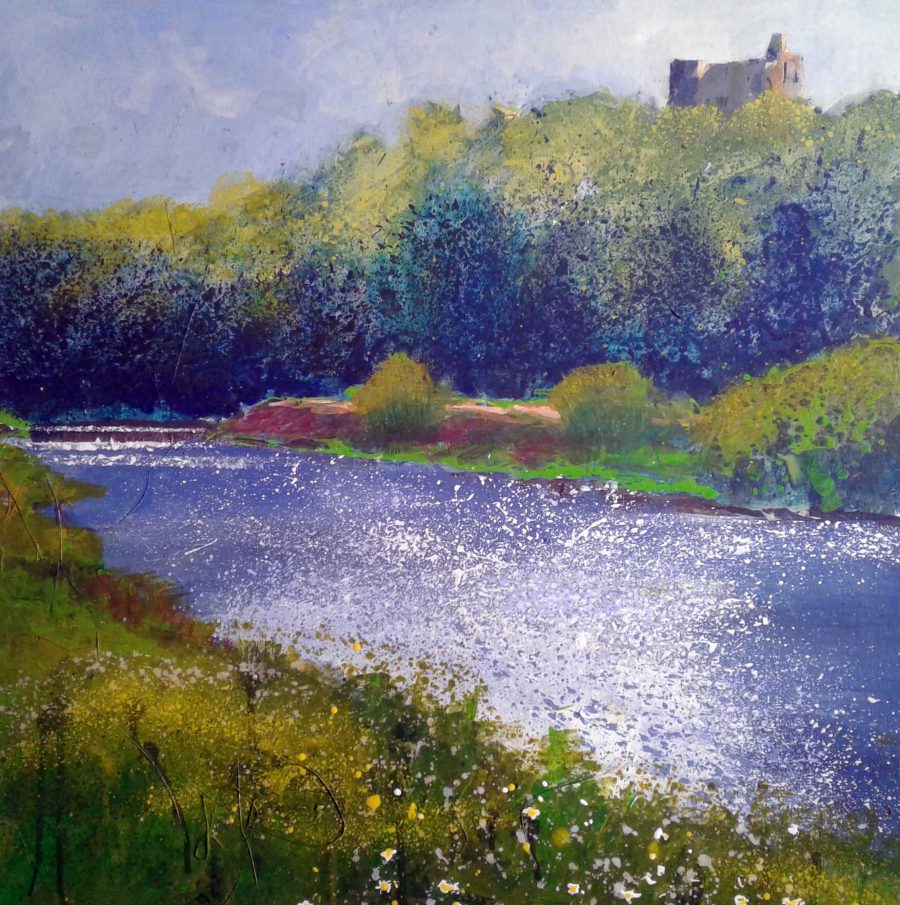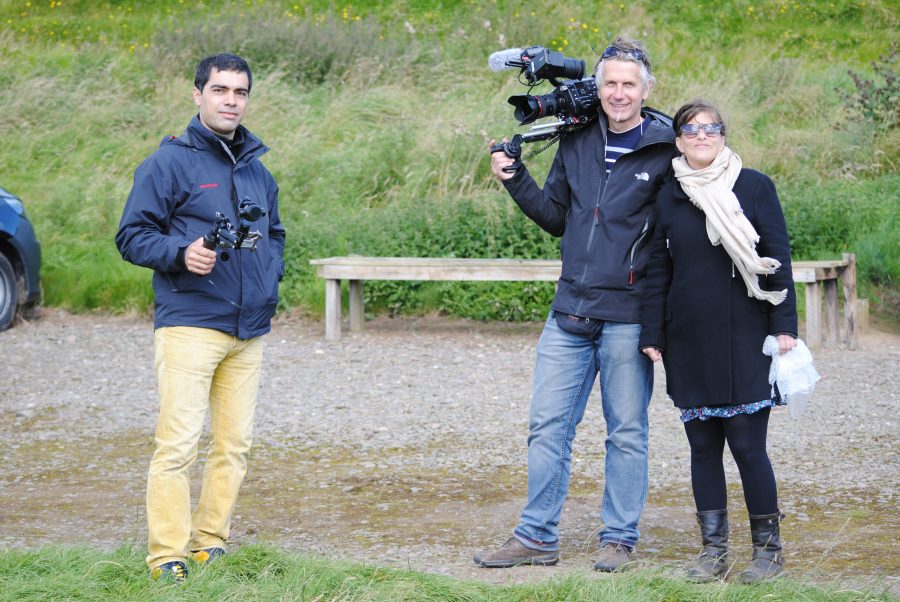Filming Norham
I spent yesterday on the banks of the river Tweed making studies of Norham Castle for a German tv film about JMW Turner. In the morning we did some location shots and established a ‘storyline’ and in the afternoon I was to make a painting from as near to Turner’s viewpoint as we could find. Turner painted Norham from the English side of the river but the bank has since eroded and tree growth almost entirely obscures the castle so we found a spot on the Scottish side that we felt would work…….it proved to be more difficult than I’d anticipated.
The afternoon started well enough, as bright sunshine lit the castle and the Tweed danced and sparkled on its course to Berwick and the sea, but with high winds it wasn’t long before clouds were scurrying across the sky giving the light a kind of strobe effect and the trees the appearance of demented nightclub dancers thrashing around in a drunken stupor. Working with a film crew was challenging too: despite doing their utmost to make me comfortable, it’s not easy working with a film camera inches from your face whilst pretending it’s not there and at the same time giving your thoughts on Turner, painting, Scottish weather and a amplitude of other subjects.
Eventually I realise that I haven’t seen the crew for a while and they have in fact stopped filming, and started munching snacks – the light has become so bad that they’ve given up and as rain has begun to fall, I take this as a cue to do the same. In good Turner tradition I had to ‘work up’ the painting in the studio on my return; this and some other sketches I made, will now function as studies for the making of an oil painting which will be filmed in my studio on Wednesday.
Anyway, here it is along with producer Ina Kessebohm and her film crew:
J.M.W. Turner’s 1797 Tour of North East England: Focus on Norham Castle
Joseph Mallord William Turner, one of Britain’s most revered landscape painters, embarked on a transformative journey through North East England in 1797. This expedition was pivotal in shaping his artistic vision and cementing his reputation as a master of capturing the sublime qualities of nature. Among the many locations he visited, Norham Castle stands out not only as a subject of his artwork but also as a symbol of the romanticism that infused Turner’s landscape painting.
The Context of Turner’s 1797 Tour
Turner was born in 1775 and had already begun to gain recognition for his watercolours and oil paintings by the time he set out on his tour of North East England. The late 18th century was a period marked by a growing interest in nature and the picturesque, influenced by the Romantic movement, which celebrated emotion and individual experience in art. This environment was fertile ground for Turner, who sought to transcend the traditional boundaries of landscape painting.
Turner’s tour in 1797 was not just a simple journey; it was a quest for inspiration. He was particularly fascinated by the interplay of light, atmosphere, and the dramatic effects of weather on the landscape. His travels took him through various regions, including the scenic vistas of Northumberland, where Norham Castle caught his eye.
Norham Castle: Historical Significance
Norham Castle, located on the north bank of the River Tweed near the Scottish border, has a rich history that predates Turner’s visit. Originally built in the 11th century, the castle served as a strategic fortification due to its proximity to the border with Scotland. It witnessed numerous sieges and conflicts, particularly during the tumultuous periods of the Middle Ages. By the late 18th century, however, it was largely in ruins, its crumbling walls and towers exuding a sense of romantic decay that would deeply resonate with Turner.
The castle’s imposing silhouette against the expansive sky and rugged landscape provided a dramatic focal point for Turner. It was not merely a subject to paint; it was a narrative of history, struggle, and the passage of time. Turner’s depiction of Norham Castle encapsulated both its physical presence and its emotional resonance.
Artistic Interpretation
During his visit, Turner created a series of sketches that would later inform his paintings. His style during this period was characterised by loose brushwork, emphasising the play of light and atmosphere over detailed representation. One of the notable sketches from this period is “Norham Castle,” where Turner captured the castle’s ruins set against a turbulent sky. This sketch highlights his keen observation of natural phenomena and foreshadows the dramatic use of colour and light that would become a hallmark of his later works.
In his paintings, Turner often infused his landscapes with a sense of movement and energy, reflecting his fascination with the sublime. At Norham Castle, he employed a dynamic composition that draws the viewer’s eye across the canvas, showcasing the interplay of light and shadow. The clouds swirling above and the river below create a sense of continuity, connecting the earth and sky in a dramatic embrace.
Turner’s choice of colour further enhanced the emotional impact of his work. He was known for his innovative use of colour to convey mood and atmosphere. In his depictions of Norham Castle, hues of warm ochres and deep blues evoke a sense of impending change, perhaps reflecting the historical turbulence associated with the site. This emotional depth is a hallmark of Turner’s later works, establishing him as a pioneer of Romantic landscape painting.
Influence and Legacy
Turner’s engagement with Norham Castle did not go unnoticed. His works from this period inspired not only his contemporaries but also future generations of artists. The romanticised portrayal of ruins became a popular theme in the 19th century, influencing the likes of John Constable and the Pre-Raphaelite Brotherhood, who admired Turner’s ability to evoke emotion through landscape.
Moreover, Turner’s exploration of light and colour paved the way for the Impressionist movement in the late 19th century. Artists such as Claude Monet would later build upon Turner’s techniques, focusing on the effects of light and atmosphere in their own landscapes.
Turner’s relationship with Norham Castle also speaks to a broader cultural fascination with ruins during the Romantic era. Ruins were often seen as embodiments of nostalgia and the passage of time, inviting contemplation on history, memory, and the transience of human achievement. Through his work, Turner contributed to this discourse, using Norham Castle as a poignant example of how landscapes can evoke deep emotional responses.
Conclusion
J.M.W. Turner’s 1797 tour of North East England, particularly his engagement with Norham Castle, marks a significant chapter in his artistic journey. Through his sketches and subsequent paintings, Turner not only captured the physical beauty of the landscape but also infused it with layers of meaning and emotion. Norham Castle, with its storied past and dramatic presence, became a symbol of the sublime, reflecting both the natural world and the complexities of human experience.
As we reflect on Turner’s legacy, we recognise the profound impact his work had on the trajectory of landscape painting. His innovative techniques and emotional depth continue to resonate with artists and art lovers alike, inviting us to explore the interplay of nature, history, and the human spirit in our own understanding of the world.


